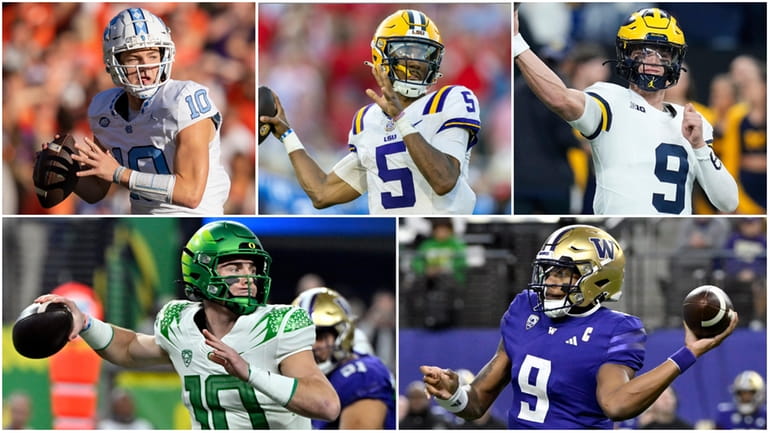Giants doing their homework on QB draft class

Clockwise, from left: Drake Maye of North Carolina, Jayden Daniels of LSU, J.J. McCarthy of Michigan, Michael Penix Jr. of Washington, Bo Nix of Oregon. Credit: AP / Jacob Kupferman; AP / Vasha Hunt; AP / Darron Cummings; AP / David Becker
This is one of Brian Daboll’s favorite times of the year.
Odd, perhaps, for a football coach to be so into early spring when his team isn’t even assembled and the games on which he’ll be judged are still five months away. But this is when he gets to trot around the country and meet the incoming crew of quarterbacks who will be available in the upcoming draft.
Bouncing between pro days and private workouts, Daboll racks up his allotment of frequent flyer miles getting to know the young men who will be vying to become the next Peyton Manning or Tom Brady . . . even though the majority of them, statistically, will wind up as the next cautionary tale in a league where assessment and development at that position have become a bigger crapshoot than the coin tosses that open each game.
“I love evaluating quarterbacks,” Daboll said this week at the NFL’s annual meetings in Orlando. “I love meeting with the quarterbacks. It's an awesome position to work with, and it’s a really fun position to evaluate.”
For most of the past five years, Daboll has done it as a contingency. A sort of hobby. Ever since his first season in Buffalo as the offensive coordinator when he helped the Bills pick Josh Allen in 2018, his yearly exercises have been aiming toward the deep future.
“I love doing it because two years from now or three years from now, whenever it may be, who knows if those quarterbacks are going to be out there,” he said. “The last few years it seems like there’s a bunch of them.”
Earlier this month, the Giants signed Drew Lock based mostly on the work Daboll had done on him when he was a 2019 pick out of Missouri.
This spring, though, the Giants coach's info gathering has felt much more immediate and urgent.
If you believe the Giants — and at this point there is little reason not to — they are open to but have yet to decide if they are going to select a quarterback near the top of the draft that begins a little less than a month from now. However, they are certainly acting the part of coy buyers, doing all the necessary legwork and eyeballing that goes into determining which, if any, of the highly-regarded prospects in this year’s crop might be a good fit for them.
And because of that, they are much closer to such a franchise-impacting call today than they were even a week ago.
Daboll and general manager Joe Schoen have been to pro days at LSU and Washington since leaving Orlando to spend precious time with, among others, quarterbacks Jayden Daniels and Michael Penix Jr. Assorted other coaches and front office executives were at North Carolina to hang with Drake Maye at his pro day. Many of those decision-makers will reportedly be spending this Easter Sunday in Michigan holding a private workout for J.J. McCarthy, who, like Bo Nix from Oregon, has already visited the Giants’ facility in East Rutherford, New Jersey.
These Giants have been leaving a trail of Kaiser rolls, not just breadcrumbs, as they scour the nation for a potential Daniel Jones replacement.
Daboll and Schoen were part of the quarterback hunt that landed Allen, although they were both lieutenants at the time and not the main deciders. Now they are relying on that experience — and their cumulative experiences since — to determine what the Giants will do on April 25.
“We believe in our draft process in general, not just the quarterback position,” Schoen said this week. “It’s an inexact science, and you try to do as much homework as you can to eliminate the margin for error and make the best decision . . . Ultimately our process will lead us to making good decisions.”
So what is that system which, for the first time, seems poised to be employed as the Giants’ process? What are the Giants looking for as they meet with these players and try to come to a “conviction” on any, some, or all of them?
The word Daboll stressed in regard to the on-field analysis is “accuracy,” but, like a quarterback with a rocket for an arm, it goes so much deeper than that.
“You get to meet the individual and see how they handle things, their leadership abilities, their communication style,” Daboll said. “And then you watch all the games. It’s not a cut-up of games where you are looking at targets or run blocks [as with other positions]. You're watching everything and seeing how they respond. How do they respond in two-minute situations? How do they respond after an interception? What does the play look like after a few bad plays or a few incompletions? There’s no exact science in it. It's obvious that there isn't. You do the best job you can.”
“I think you have to prioritize it all,” Schoen said. “It's one thing to do the work in the fall and see a guy play, but I think the other half is equally as important, being around the player. How smart are they? Can they process information? Can they handle the market that we're in? There's a lot of unknowns. How are they going to face adversity? How are they going to react? It's not just what you see on the film. That's obviously important, but I think the other part is equally as important, specifically at that position.”
So that’s what they have been doing. They are getting to know the men. And in a matter of weeks one of them might very well become the most important player they have ever selected . . . or passed on.
Schoen certainly understands the weight of that decision.
“It's not like if this guy fails at corner we can move him to nickel or he's at least our third tackle or our third nickel rusher,” he said of drafting other positions. “The fail factor [at quarterback] is you are either a backup that bounces around or you're out of the league.”
It is roughly the same with the coaches and general managers who make those quarterback picks, too.
Daboll and Schoen haven’t been in a position to do that in a few years, but they have gone through the exercises each spring. Call them practice rounds as they prepare for this year’s opportunity to actually employ the information they have gathered.
“It's a premium position, obviously,” Daboll said of quarterbacks. “It takes a long time to evaluate. You have to put a lot of work into it. It's an all-encompassing process. I've done that every year in which I've coached quarterbacks, been a coordinator, been a head coach. This will be no different.”
Unless, of course, by the final step, it is different, and the quarterback becomes his.
SCOUTING THE QBs
The top quarterback prospects the Giants have been scouting heavily the past few weeks:
Jayden Daniels, LSU
The reigning Heisman winner completed 72% of his passes for 3,812 yards, 40 touchdowns and four interceptions in 2023 and also ran for 10 scores. His pro day performance was top notch.
Drake Maye, North Carolina
A natural pocket passer, Maye completed 63% of his passes for 3,608 yards, 24 touchdowns and nine interceptions in 2023. He ran for another nine TDs. If Eli Manning and Daniel Jones show the Giants have a “type,” Maye could be next in line.
J.J. McCarthy, Michigan
The QB most often linked to the Giants, his most impressive stat is his won-loss record of 27-1 and a national championship in college. He completed 72% of his passes for 2,991 yards, 22 touchdowns and four interceptions with three rushing TDs.
Bo Nix, Oregon
The Giants got to see Nix up close at the Senior Bowl. In 2023 he completed 77% of his passes for 4,508 yards, 45 touchdowns and three interceptions with six rushing TDs.
Michael Penix Jr., Washington
A long injury history could dampen interest in the lefty who completed 65% of his passes for 4,903 yards, 36 touchdowns and 11 interceptions, but he might have the best throwing arm among the bunch.

